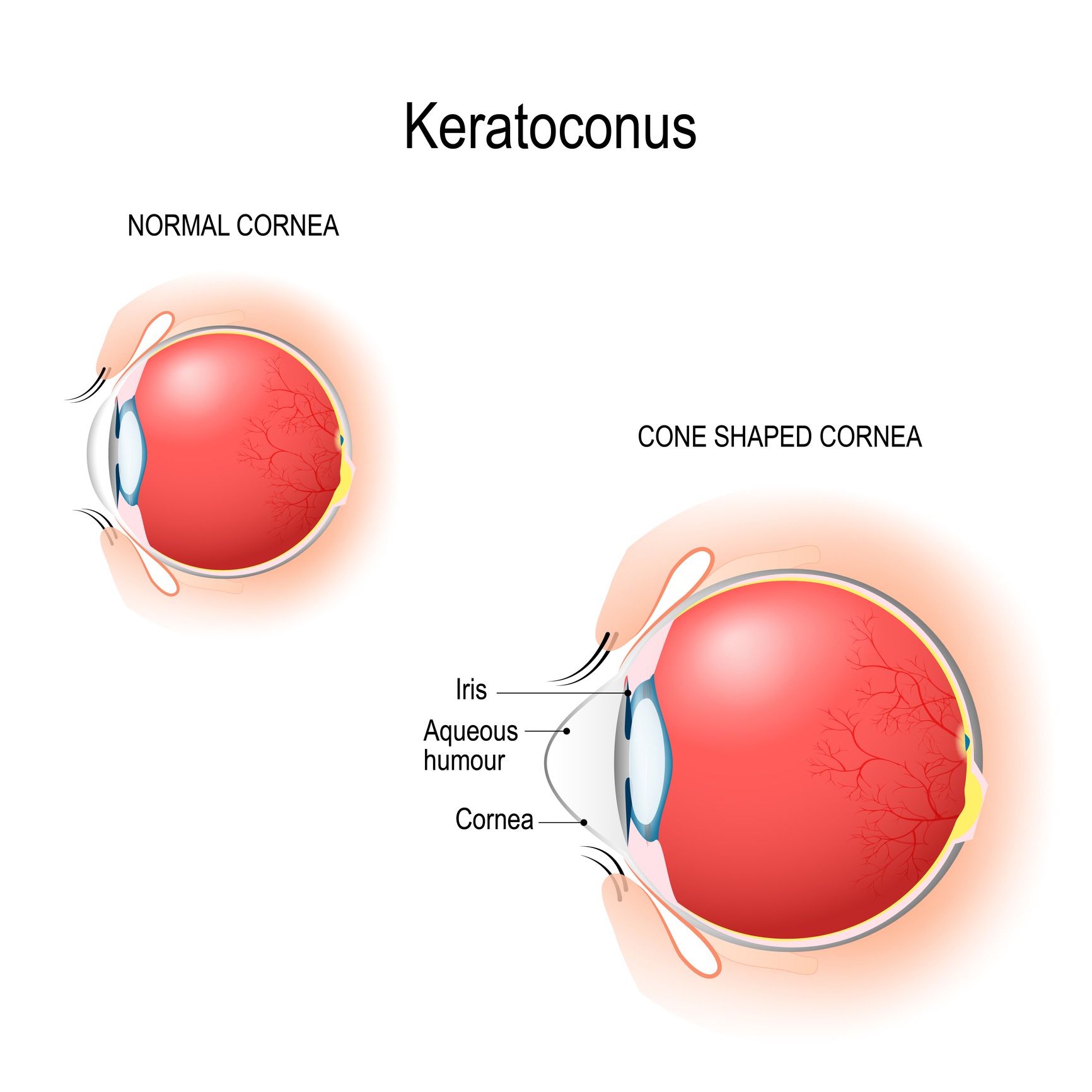What is Keratoconus?

Keratoconus is a condition that affects the cornea (the clear outer layer of your eye). Normally a round dome shape, if the corneal tissue begins to thin, it can begin to bulge out into a cone shape. Because the shape of the cornea becomes distorted, your eyesight also becomes distorted because light will not focus properly on the retina (back of the eye). This makes normal activities such as reading, watching TV, driving or working on a computer very difficult.
Who Gets Keratoconus
Many people are surprised to learn that keratoconus usually affects people who are in their late teenage years or early 20s. This is a condition that affects 1 in 2,000 of the general population. The condition is hereditary in some cases. It may also be caused by an enzyme imbalance in the cornea that causes the corneal tissue to weaken.
Symptoms of Keratoconus
Not all patients will experience keratoconus symptoms right away. In fact, it can progress over a 10-20 year period and result in symptoms such as:
- Vision distortion
- Blurry vision
- Light sensitivity
- Irritation
- Glare
- Ghosting
Keratoconus Treatment
Luckily there are a variety of treatment options to help patients with keratoconus see more clearly. Some are covered by insurance. Depending on the severity of your condition our Colorado Springs keratoconus doctors may recommend:
- Prescription glasses
- Rigid contact lenses
- iLink™ corneal cross-linking
- Intacs® corneal implants
- Corneal transplant in severe cases
iLink™ Corneal Cross-linking
We are excited to offer the first and only corneal cross-linking treatment approved by the FDA for progressive keratoconus in patients over age 14. During this treatment, your doctor gently removes a thin layer of your cornea, applies prescription Photrexa® eye drops into your eyes and then shines ultraviolet (UV) light from the KXL® System into your eyes. This combination helps to strengthen weak corneas. This seemingly simple – and typically comfortable – process helps create new corneal cross-links to reinforce the corneal structure.
While this is not a cure for keratoconus, iLink can be effective in slowing the progression of the disease, reducing the need for corneal transplants and helping preserve vision. Some patients only require one treatment but they may still need to wear prescription glasses or contact lenses to achieve their best vision possible.
Recovery from Corneal Cross-linking
When the treatment is complete, a protective bandage contact lens is placed on the surface of the eye. After the numbing drops wear off, you may experience some discomfort such as a gritty, burning sensation and light sensitivity. This can be managed with over-the-counter pain medication and artificial tears. If pain is severe, prescription medication may be prescribed. It is important to not rub your eyes for the first 5 days after the procedure. If your bandage contact lens becomes dislodged, you have a sudden decrease in vision or have any severe pain, contact us immediately.
Safety of iLink Corneal Cross-linking
When performed by an experienced ophthalmologist like our team at Skyline Vision Clinic & Laser Center, corneal cross-linking in Colorado Springs is considered safe for people between the ages of 14 and 65. Safety has not been established for women who are pregnant or breastfeeding. Some of the risks include serious eye infection (ulcerative keratitis), pain, hazy/blurry vision, dry eye, fine white lines and disruption of the surface cells. However, the majority of these adverse effects are temporary and resolve in the first month.
Intacs® Corneal Implants
Intacs are small, micro-thin corneal implants that are inserted into your cornea. They are designed to reshape the curvature of the cornea by adding ultra-thin ring segments to push out the sides of your cornea, shaping your eye so it is round again. The implants are comfortable, invisible and maintenance-free.
The procedure takes about 15 minutes per eye.
- A small incision is made on the cornea.
- Your doctor separates the inner layers of the cornea to allow for the insertion of the implant.
- The implants are carefully and gently placed into the eye to flatten the cornea.
- The incision is closed.
After the procedure, you will need someone to drive you home. Some patients report seeing better after the first day; others may need a couple days of rest to maximize healing time. Depending on your degree of keratoconus, you may still need glasses or contact lenses for functional vision.
If you or a loved one is experiencing any keratoconus symptoms, schedule an eye exam with our team to learn more about keratoconus treatments in Colorado Springs.
